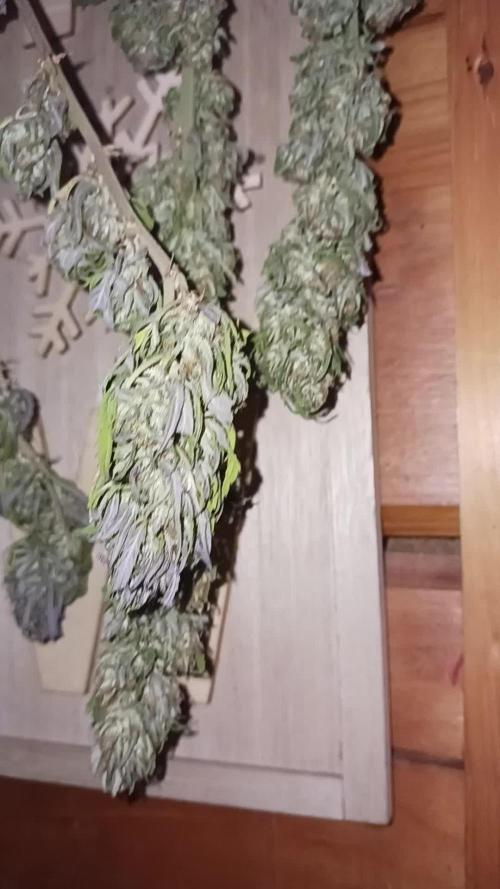By continuing to use the website or clicking Accept you consent to our cookies and personal data policy and confirm that you are at least 18 year old. For details please see Privacy Policy and Terms
Accept
Likes
Comments
Share


@King_KanaZai
Follow
Coupe effectué sur les feuille déformé et sur la tête principale pour effectué une division. Toujours aucun signe de parasite ou de maladie.
Likes
21
Share


@Trickybis82
Follow
OK hi growmies,
I'm in to final flush week with purple lemonade. She looks and smells amazing so 7days until we cut her down :()
Also wedding cheesecake coming along beautifully. Her aroma is amazing and creamy with the hint of cheese and I j8st cannot wait... i have a couple more weeks for her and Grape gushers...
Next week i will have pics and videos or crop from purple lemonade 💜
Still will have curing process and final taste to show and describe.
Shout out to these auto seed companies
@420FASTBUDS @TASTEBUDZ
Likes
12
Share


@BeHappyNtoke
Follow
everything is still going great new growth starting to show trying to debate on the veg time due to small pots introduced a slight breeze to strengthen stem
Likes
1
Share


@HonoluluBob
Follow
Extremer Regen und kalte Tage.
Die Schnecken haben ihren Anteil gefordert.
Likes
13
Share


@Gorilaweed420
Follow
Muchas gracias por dejarme participar BsF y grow diariaries y compartir este cultivo gorila glue 4. Fue un hecho en scroog en un metro veinte cuadrado usando dos masetas de 23 ltrs usanso microorganismos y productos orgánicos súper contento con esta sepa, fueron criadas con dos focos galoponeros en un armario con poco a lo q tengamos podemos hacer mucho lo importante es aprender un poco todos los días y disfrutar de nuestras cosechas un fuerte abrazo para todos @gorilaweed420
Processing
Likes
8
Share


@Greenbean15
Follow
Seeing lots of good development, Pineapple Express is almost there!
I went ahead and defoliated the light bleached leaves, trichomes are getting more cloudy. Spotted a few amber trichomes but not many... update- varies by bud. Trich’s appear mostly cloudy to me. Looking at harvesting maybe mid-week next week... 5 more days or so... maybe sooner if trichomes becomes more amber! Super excited to see how this Pineapple Express turns out! Went ahead and clipped the bud off her that had been pollinated, she was starting to open up some of the seed pods. Seeds look fully developed and are quite dark. Tester bud had a few seeds in it but not outrageously so, only a few.
Berry white is trucking along, lots of trichome development this week but buds still don’t seem to be swelling much. Smell coming off this little plant is fantastic!
Likes
100
Share


@AsNoriu
Follow
Day 71. Girls went through two plain waterings, planing to give tomorrow first feed without BioGrow. Will try to ramp everything and achieve 800 ppm.
No space, girls are showing signs of few top bleach and foxtailing starting ...
All Northern Lights are like two weeks behind ...
One Green Crack is rocking my soul with sizes of buds - FATASS buds ;)))
Diesels are looking fantastically too !!!
Amazing house !
Day 74. Chopped FB LSD 25, so got a bit more space, but those side plants missed space a lot !!! Some big branches on Northern Lights died off without proper light and space , so now they should be happier ...
Day 75. Girls loved more space and I think two first Alaskan Diesel will fall in 10-14 days. Cut food for them now ! All others are pushing and looking very promising !
Happy Growing !!!
Likes
5
Share


@Mario_buds
Follow
This plant was RIP ed out of the ground and put inside looks bit fucked but shes smell so nice I ripped a bud off to smoke and boy is she strong
Likes
13
Share


@XanHalen
Follow
Apr 09:
Things are chuggin along, i think light may have been a factor in the brown spots, seeing similar symptoms on one of the other plants but very very minor in comparison....
I think it was too little calmag, i may have locked them out mid veg by using high concentration of nutes without watering till runoff (i now know, that is a no-go), and light stress. i have had them under 850-1050 ppfd when flipped to flower...
one of them is loving the light, one is big and bushy (had to defoliate later than i wanted), and one has good bud structure but pistils seem thin, and growth seems slower (the one with the brown polkadot party on its body) so thinking it may be stunted.
either way, im seeing denser buds, and im learning the ropes, thats enough for me :)
Apr 12:
Last feed day...
Trichomes look just about ready, will do 2 runoff waterings 48hrs apart, then 24-36 hr darkness...
Will try to post trichome pics....
Super excited to see the improvements from this run vs last run...!
Likes
14
Share


@CrazyRussian
Follow
Here we go, this is the ninth week of growing. The plants look, and smell incredible right now, I've started flushing last week, and will continue this week , and I hope to make the harvest next Saturday. By the time I've been removing a lot of leaves, because they started to turn yellow, as the cycle of the plants is getting to its end. I am really satisfied with the overall quality of this plant, every aspect of it is amazing! My retarded daughter is getting herself together, but she still has almost 3-4 weeks until she's ready.
Likes
18
Share


@Ultraviolet
Follow
*Pre-flowers have micro trichomes upon formation, LOL. Based on my early observation, I predict that these will be frosty frosty on the trichomes.
Added 20lbs of black lava rock as mulch, raising soil temp around 1 and a half degrees to 72.8F.
Some nice little bud formations are creeping up already. Nice little foliar spray of some aminos to the underside of the leaf. Hard to guage or know how much the aminos help, but after reading how energy intensive it is for the plant to make them from scratch its something I feel I need to do as a habit.
An EC (Electrical Conductivity) meter, one that's made for the soil, it's so useful, as it indirectly indicates soil moisture as well as salt mineral nutrient levels. Just pop your metre stick in the soil and if ec is low, then it's time to water. Once there is water to assist in the conduction of electricity, the EC" will kick back up. 0.3-1.8, if it stays low, then you know it's time to add more mineral salt ferts! While Electrical Conductivity primarily indicates the overall salt content in soil, pH provides information about the relative proportion of cations (positively charged ions) in the soil's salt capacity. High EC signifies a higher salt concentration, while pH reflects the balance of cations like calcium, magnesium, potassium, ammoniacal nitrogen, sodium, and hydrogen.
Smaller leaves have less surface area for stomata to occupy, so the stomata are packed more densely to maintain adequate gas exchange. Smaller leaves might have higher stomatal density to compensate for their smaller size, potentially maximizing carbon uptake and minimizing water loss. Environmental conditions like light intensity and water availability can influence stomatal density, and these factors can affect leaf size as well. Leaf development involves cell division and expansion, and stomatal differentiation is sensitive to these processes. In essence, the smaller leaf size can lead to a higher stomatal density due to the constraints of available space and the need to optimize gas exchange for photosynthesis and transpiration. In the long term, UV-B radiation can lead to more complex changes in stomatal morphology, including effects on both stomatal density and size, potentially impacting carbon sequestration and water use. In essence, UV-B can be a double-edged sword for stomata: It can induce stomatal closure and potentially reduce stomatal size, but it may also trigger an increase in stomatal density as a compensatory mechanism. It is generally more efficient for gas exchange to have smaller leaves with a higher stomatal density, rather than large leaves with lower stomatal density. This is because smaller stomata can facilitate faster gas exchange due to shorter diffusion pathways, even though they may have the same total pore area as fewer, larger stomata
Sugars, classified as carbohydrates, are composed of the elements carbon (C), hydrogen (H), and oxygen (O). They are characterized by the general formula (CH2O)n, where 'n' represents the number of carbon atoms. The most basic units of sugars, called monosaccharides, have this ratio of carbon, hydrogen, and oxygen. For example, glucose and fructose, both monosaccharides, have the formula C6H12O6.
The reality of your typical plant. After harvest, with all water remove,d you are left with. (Ballpark)
Mother-nutrients: Carbon 47%, Oxygen 43%, Hydrogen 4%.
Macro-nutrients: Nitrogen 3%, Phosphorus1%, Potassium1%, Calcium1%, Magnesium0.5%, Sulfur0.5%.
Micro-nutrients: All the rest combined 1%
Nothing good can happen in a soil that can't breathe. The aerobic zone in soil is crucial.
Microorganisms can break down sugars into their constituent atoms, though they don't typically do so completely to the individual elemental level (carbon, hydrogen, oxygen) in one step. Microorganisms utilize sugars through metabolic pathways like glycolysis and fermentation, converting them into simpler molecules like pyruvate and then potentially to other compounds like lactic acid, ethanol, or carbon dioxide, releasing energy in the process.
Glycolysis:
This is a central pathway where a glucose molecule (a common sugar) is broken down into two molecules of pyruvate. This process generates some ATP (energy) for the cell.
Fermentation:
If oxygen is limited, some microorganisms can ferment pyruvate, producing various end products like lactic acid (in lactic acid fermentation), ethanol and carbon dioxide (in alcoholic fermentation), or other organic acids.
Further Breakdown:
The products of glycolysis and fermentation can be further broken down through other metabolic pathways, potentially leading to the release of carbon dioxide and water, and the extraction of more energy.
Not Always to Atoms:
While some microorganisms can completely oxidize sugars to carbon dioxide and water, releasing all their energy, others may stop at intermediate stages, producing various organic compounds.
Role of Enzymes:
Microorganisms use specific enzymes to catalyze each step in these breakdown pathways.
In summary, while microorganisms don't typically reduce sugars to individual atoms in one go, they break them down into simpler molecules, releasing energy and potentially forming new compounds as part of their metabolism.
In conditions of high CO2 concentration, the pH of a solution or system will decrease, becoming more acidic. Conversely, low CO2 concentrations lead to an increase in pH, making the solution more alkaline or basic. This relationship is due to the chemical reactions involving CO2 and water, which produce carbonic acid and influence the concentration of hydrogen ions, ultimately determining the pH





































